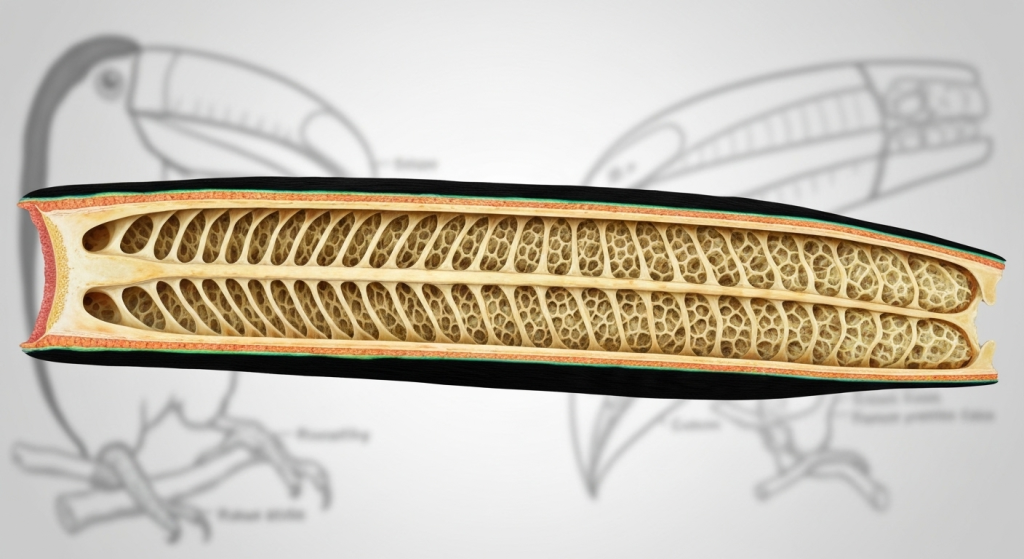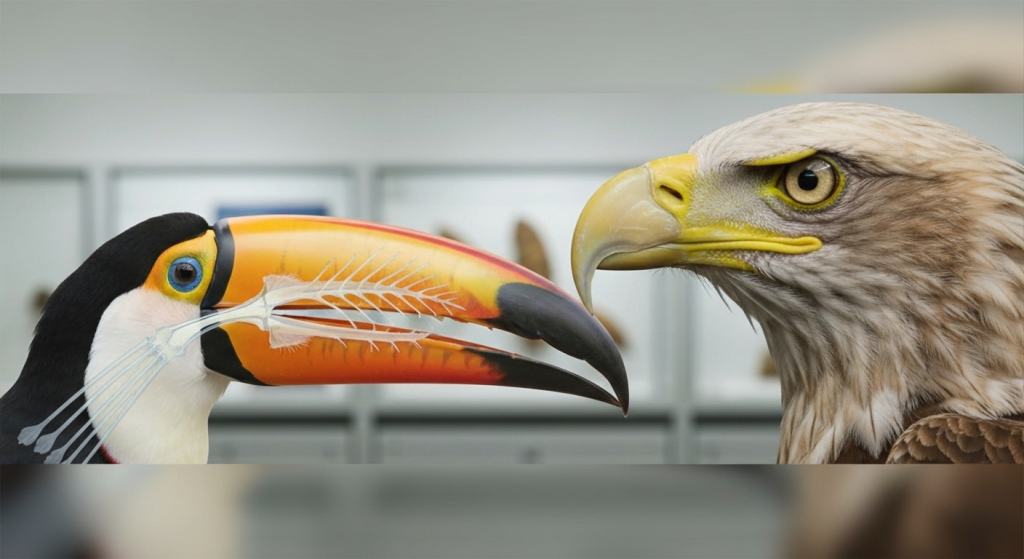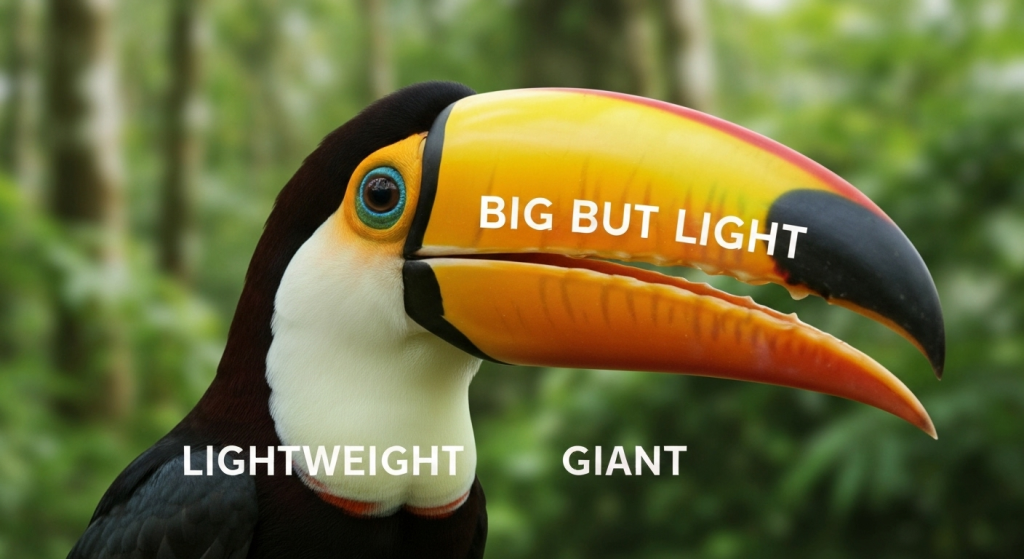The toucan is one of the most recognizable birds in the world, largely thanks to its enormous, brightly colored bill. When you first see one, whether in a photo or the lush canopies of a tropical forest, a simple thought often comes to mind: that thing must be incredibly heavy. It looks like a solid, hefty piece of bone attached to the bird’s face, making you wonder how it can even lift its head, let alone fly. But here’s the thing, that common assumption is completely wrong.
The toucan’s bill is a marvel of natural engineering, a masterpiece of evolution that combines impressive size and strength with shockingly low weight. It’s not a clumsy, burdensome appendage; it’s a highly sophisticated, multi-purpose tool that is essential to the bird’s survival. Understanding the secrets behind its structure reveals a fascinating story of how nature solves complex problems with elegant and efficient design. This article breaks down the science behind the toucan’s bill, exploring its internal structure, its many functions, and how it achieves its remarkable strength-to-weight ratio.
For years, I’ve been captivated by the unique adaptations of different bird species. My work has often involved digging into scientific literature to understand not just what a feature is, but why it evolved that way. Mahnoor Farooq has been exploring and writing about Bird Species for years, bringing research, cultural context, and clear explanations to readers. My fascination with toucans, in particular, began when I first held a museum specimen of a Toco toucan’s skull. The visual disconnect between expecting a heavy object and feeling something almost as light as styrofoam was startling. That moment sparked a deep dive into the biomechanics of this incredible structure, revealing it to be so much more than just a colorful beak.
A Look Inside: The Secret to the Toucan’s Lightweight Bill

The primary reason the toucan’s bill is so light lies in its internal composition. It is not a solid piece of bone. Instead, the inside of the bill is a complex matrix of bony struts and supports, crisscrossing to form a rigid, honeycomb-like structure that is mostly hollow. This internal framework, made of bone called trabeculae, provides incredible structural integrity without the mass and density of a solid material. Think of it like the steel truss system used to build a bridge or a skyscraper—engineers use interconnected beams to distribute weight and withstand force, leaving large empty spaces to save on materials and reduce overall weight.
This foam-like interior is a biological masterstroke. It makes the bill strong enough to grasp fruit, spar with other toucans, and defend against predators, yet light enough that it doesn’t hinder the bird’s ability to fly or move its head with agility. The structure is composed of a network of thin, bony rods and membranes that enclose pockets of air. This design maximizes strength at key stress points while minimizing the amount of biological material needed. It’s a perfect example of nature optimizing for efficiency, creating a tool that is both large and functional without being a physical burden.
I remember examining a detailed CT scan of a toucan bill during a research project. The intricate, almost web-like pattern of the internal bone was breathtaking. It didn’t look like bone at all; it resembled an advanced composite material designed by an aerospace engineer. The design allows the bill to withstand the twisting and gripping forces needed for feeding while being resilient to minor impacts.
Solid Bone vs. Honeycomb Structure: A Comparison
To truly appreciate this design, it helps to see a direct comparison between what we might expect (solid bone) and what the toucan actually has.
| Feature | Solid Bone Structure (Hypothetical) | Toucan Bill (Honeycomb Structure) |
| Weight | Extremely heavy and dense. | Exceptionally lightweight, mostly air. |
| Strength | Very strong against compression. | High strength-to-weight ratio; resilient. |
| Mobility | Would make flight difficult or impossible. | Allows for agile head movement and flight. |
| Metabolic Cost | High cost to grow and maintain. | Low metabolic cost to produce. |
| Brittleness | Prone to catastrophic fracture. | More flexible; can absorb impact better. |
| Thermoregulation | Poor at dissipating heat. | Excellent for radiating body heat. |
More Than Just a Pretty Face: The Keratin Sheath
While the honeycomb core provides the lightweight framework, the bill’s exterior is what gives it a smooth surface, its vibrant colors, and an extra layer of durability. This outer layer is a thin shell made of keratin, the same fibrous protein that makes up our hair and fingernails, as well as the claws, scales, and horns of other animals. The toucan’s bill is covered in overlapping layers of this tough material, forming a sheath known as a rhamphotheca.
What’s remarkable is how thin this keratin shell is—in many species, it’s only about 0.5 millimeters thick. Yet, it’s incredibly resilient and provides a tough, protective covering for the delicate bone structure underneath. This sheath is also responsible for the brilliant and varied colors seen on toucan bills. The colors are produced by pigments, primarily carotenoids, deposited within the keratin layers. These colors serve as a form of communication, helping toucans identify members of their own species, attract mates, and signal their health and fitness.
The keratin sheath performs several crucial functions without adding any significant weight, making it a key component of the bill’s overall design.
- Protection: It acts as a durable shield, protecting the internal honeycomb from everyday wear and tear, scrapes, and minor impacts.
- Color Display: It serves as the canvas for the bird’s iconic colors, which are vital for social signaling and mating rituals.
- Surface Integrity: It provides a smooth, continuous surface that is ideal for manipulating food, preening feathers, and interacting with the environment.
- Renewability: Like our fingernails, the keratin layer can slowly grow and repair itself from minor scratches and chips, ensuring the bill remains functional throughout the bird’s life.
Not Just for Show: The Many Functions of the Toucan’s Bill
Now that we understand how the bill is so light, the next logical question is why it needs to be so big in the first place. The massive size isn’t just for decoration; it’s a multi-functional tool that plays a critical role in almost every aspect of the toucan’s life, from eating to staying cool.
A Built-In Air Conditioner (Thermoregulation)
One of the most fascinating discoveries about the toucan’s bill is its role as a highly effective thermoregulatory organ. The bill is filled with a dense network of blood vessels, and its large surface area makes it an ideal place to shed excess body heat. On hot days in the tropical forest, the toucan can increase blood flow to its bill. As blood circulates through the vast network of vessels just under the surface, heat radiates away into the air, much like how a radiator cools a car engine.
Studies have shown that a toucan can dissipate a massive amount of body heat through its bill—sometimes accounting for over 60% of its total heat loss. This allows the bird to stay cool without having to resort to panting or other energy-intensive methods. Conversely, when the bird needs to conserve heat, such as during cooler nights, it can restrict blood flow to the bill. I’ve observed toucans tucking their bills under their wings while sleeping, a behavior that effectively insulates their personal “radiator” and helps them stay warm. This incredible ability to regulate body temperature gives the toucan a significant survival advantage in its fluctuating tropical environment.
The Ultimate Fruit-Picking Tool (Foraging)

Toucans are primarily frugivores, meaning their diet consists mainly of fruit. Their long, oversized bill is the perfect tool for this job. It gives them an extended reach, allowing them to sit on a sturdy branch and pluck berries and fruits from the tips of thinner, more fragile branches that would never be able to support their body weight. This ability gives them access to food sources that are out of reach for smaller-billed birds.
Furthermore, the edges of the bill are often serrated, like a saw. These “teeth” are not for chewing but are excellent for gripping, tearing, and peeling tough-skinned fruits. Watching a toucan manipulate a piece of fruit is a lesson in dexterity. They can toss a berry into the air and catch it in the back of their throat with surprising precision. The bill’s length and shape are perfectly adapted for harvesting the specific types of fruit found in their native habitat, making it a highly specialized feeding instrument.
A Warning Sign and a Weapon (Defense and Mating)
The bill’s intimidating size and bright colors also play a crucial role in social interactions and defense. While it’s too lightweight to be a powerful crushing weapon like a hawk’s beak, its appearance alone can be a powerful deterrent. A toucan can fend off smaller predators and intimidate rivals simply by brandishing its formidable bill. This visual threat saves the bird from having to engage in physical confrontations, conserving valuable energy.
The bill is also used in social contexts with other toucans. They engage in “bill fencing” or sparring, which can be part of courtship rituals or territorial disputes. During these interactions, they gently (or sometimes not-so-gently) clash their bills together. Because the bill is so light, these duels are rarely dangerous and serve more as a test of strength and resolve. The vibrant colors also help in mate selection, with healthier birds often displaying brighter and more uniform bill colors.
Nature’s Engineering: A Masterpiece of Evolution

The toucan’s bill is a textbook example of evolutionary problem-solving. Natural selection favored a large bill because of its immense benefits for feeding, thermoregulation, and social signaling. However, a large, solid bone bill would be a liability, making flight energetically costly and movement clumsy. The evolutionary solution was to develop an internal structure that provided the necessary size and strength without the associated weight. The honeycomb matrix and thin keratin shell represent the perfect compromise, a design that maximizes function while minimizing cost.
This balance is what makes the toucan’s bill so remarkable. It’s a structure that performs multiple, complex jobs and is built with an efficiency that human engineers strive to replicate in advanced materials. When we compare it to the beaks of other birds, we see how specialized it truly is.
Bird Beak Comparison: A Look at Different Designs
| Bird | Bill Structure | Primary Function(s) | Strength Focus | Weight Consideration |
| Toucan | Hollow honeycomb with keratin sheath. | Fruit foraging, thermoregulation, display. | Gripping and torsion, not crushing. | Extremely lightweight is critical. |
| Eagle | Solid, hooked bone with thick keratin. | Tearing flesh, crushing bone. | Immense crushing and tearing power. | Weight is secondary to power. |
| Finch | Short, conical, solid bone. | Cracking hard seeds. | High compression force. | Small size keeps weight low. |
| Woodpecker | Chisel-like, thick, reinforced bone. | Drilling into wood. | Extreme impact resistance. | Skull and neck are reinforced. |
Frequently Asked Questions
Is a toucan’s bill heavy?
No, it’s surprisingly lightweight. Despite its large size, the bill is mostly hollow inside, with a honeycomb-like bone structure that provides strength without adding mass. It’s composed of about 5% bone and 95% air.
Can a toucan’s bill break?
Yes, it can. While the bill is remarkably strong for its weight and can withstand the pressures of daily use, a severe impact from a fall or a fight with a predator can cause it to crack or break.
Does the bill grow back if it gets damaged?
Minor damage to the outer keratin sheath, such as scratches or small chips, can be repaired over time as the keratin slowly grows, much like a human fingernail. However, significant structural damage to the underlying bone is permanent and will not regenerate.
Why are toucan bills so colorful?
The bright colors serve several purposes, including attracting mates, identifying members of the same species, and signaling health and social status. The colors come from pigments called carotenoids, which are deposited in the bill’s outer keratin layer.
More Than Meets the Eye
The toucan’s bill is a powerful reminder that in nature, appearances can be deceiving. What looks like a heavy, awkward burden is actually a sophisticated, lightweight, and perfectly engineered tool. From its honeycomb interior and tough keratin shell to its multiple functions as a feeding utensil, a personal air conditioner, and a social signal, the bill is a testament to the power of evolution. It demonstrates how natural selection can produce designs that are both beautiful and incredibly functional, solving complex physical challenges with elegant, efficient solutions. The next time you see a toucan, you’ll know that its most striking feature is not just for show—it’s a marvel of biological engineering.


